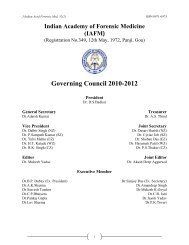JAFM-33-2, April-June, 2011 [PDF] - forensic medicine
JAFM-33-2, April-June, 2011 [PDF] - forensic medicine
JAFM-33-2, April-June, 2011 [PDF] - forensic medicine
You also want an ePaper? Increase the reach of your titles
YUMPU automatically turns print PDFs into web optimized ePapers that Google loves.
J Indian Acad Forensic Med. <strong>April</strong>-<strong>June</strong> <strong>2011</strong>, Vol. <strong>33</strong>, No. 2 ISSN 0971-097<strong>33</strong>. Potentially infected material: Excisedtumours and organs, placenta removedduring surgery, extracted teeth etc.4. Potentially infected animals used indiagnostic and research studies.5. Sharps, which include needle, syringes,blades etc.6. Blood and blood products. [10] (Table: 3, 4)Steps in Waste Management1. Washing of hands with soap and warmwater after handling BMW. Also, washing ofall areas of body with soap and water thatyou may have come into contact withbiomedical waste, even if we are not surethat body actually touched the biomedicalwaste.2. Keeping all sores and cuts covered.Immediately replace wet bandages withclean, dry bandages.3. Wear disposable latex gloves when handlingBMW. Discard the gloves immediately afteruse.4. Wear an apron or another type of cover toprotect clothes from contact with the waste.If clothes become soiled, put on freshclothes, and take a shower, if possible.Launder or throw away clothes soiled withbiomedical waste.5. Promptly clean and disinfect soiled, hardsurfacedfloors by using a germicidal orbleach solution and mopping up with papertowels.6. Clean soiled carpets. First blot up as muchof the spill as possible with paper towels andput the soiled paper towels in a plastic lined,leak-proof container. Then try one of thefollowing:Steams clean the carpet with an extractionmethod. Scrub the carpet with germicidal rugshampoo and a brush. Let the carpet dry,and then vacuum it.7. Never handle syringes, needles, or lancetswith hands. Use a towel, shovel, and/orbroom and a dustpan to pick up these sharpobjects. Dispose of them in a plastic sodapop bottle with a cap. Tape down the bottlecap. Then throw the bottle in the trash.Rules and Regulations Governing theDisposal of Biomedical Waste:I. Biomedical waste Storage andContainment:Sort and separate BMW from otherwaste at the point where the waste is created.Keep it away from direct contact with humans,animals, insects, and environmental elements,such as rain and wind. Limit access only toII.people who are trained and authorized to handlethis waste.Sharps must be contained in leak-proof,rigid, puncture-resistant, break-resistantcontainers which are labelled and tightly liddedduring storage, handling, and transport.For BMW, excluding sharps, dispose ofthe waste in leak-proof plastic bags strongenough to prevent ripping, tearing, breaking, orbursting under normal conditions of use. Rigidplastic, single-use, or approved multiple-usemarked containers may also be used. BMW thatis held in plastic bags should additionally beplaced in another leak-proof container such asdisposable or reusable pails, drums, or binsduring storage or transport. Secure bags orcontainers to prevent leakage or expulsionduring storage.The container holding the BMW shouldbe conspicuously labelled with the internationalbiohazard symbol and the words "BiomedicalWaste" (or words that clearly denote BMW).Disposal:• BMW must not be compacted or placed intothe regular garbage before it isdecontaminated.• Trash chutes must not be used to transferBMW.• BMW, except sharps, must be treated ordelivered to a BMW storage/treatmentoperator within fourteen (14) days, unlessotherwise approved by the health officer.• Sharps waste must be disposed of or betransported to a storage treatment facilitywithin ninety (90) days starting from the timethe sharps container is sealed.Expenditure in Biomedical WasteManagement:The cost of construction, operation andmaintenance of system for managing wasterepresents a significant part of overall budget ofa hospital, if the BMW handling rules have to beimplemented in their true spirit. Self-containedon-site treatment methods may be desirable andfeasible for large healthcare facilities, but not bepractical or economical for smaller institutes.An acceptable common system shouldbe in place which will provide regular supply ofcolor coded bags, daily collection of infectiouswaste, and safe transportation of waste to offsitetreatment facility and final disposal with suitabletechnology.Conclusion:Safe and effective management ofwaste is not only a legal necessity but also asocial responsibility. Lack of concern, motivation,awareness and cost factor are some of the147


![JAFM-33-2, April-June, 2011 [PDF] - forensic medicine](https://img.yumpu.com/43461356/55/500x640/jafm-33-2-april-june-2011-pdf-forensic-medicine.jpg)

![syllabus in forensic medicine for m.b.b.s. students in india [pdf]](https://img.yumpu.com/48405011/1/190x245/syllabus-in-forensic-medicine-for-mbbs-students-in-india-pdf.jpg?quality=85)



![SPOTTING IN FORENSIC MEDICINE [pdf]](https://img.yumpu.com/45856557/1/190x245/spotting-in-forensic-medicine-pdf.jpg?quality=85)




![JIAFM-33-4, October-December, 2011 [PDF] - forensic medicine](https://img.yumpu.com/31013278/1/190x245/jiafm-33-4-october-december-2011-pdf-forensic-medicine.jpg?quality=85)


